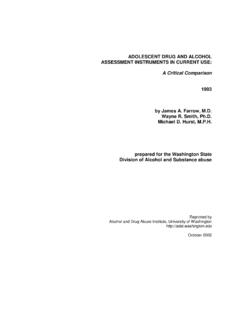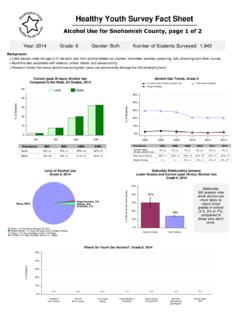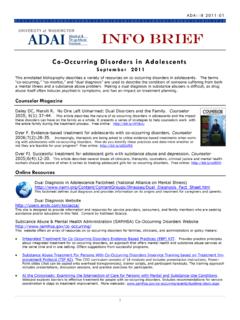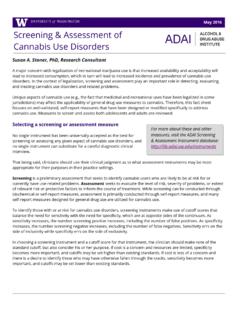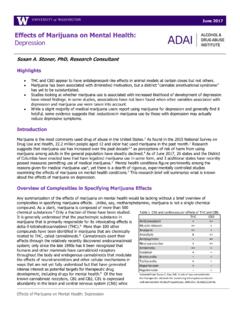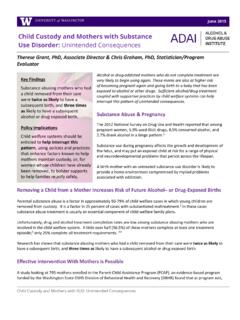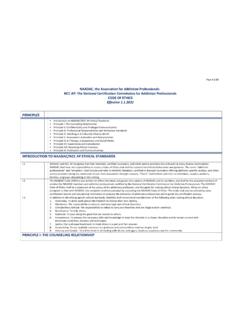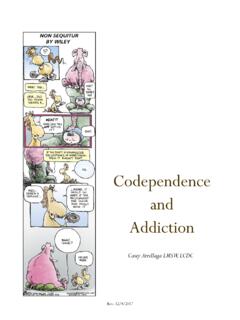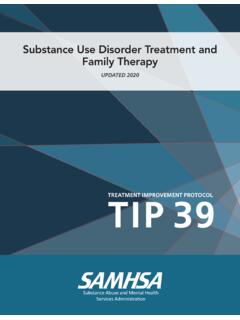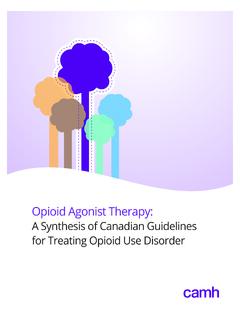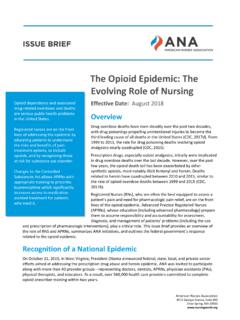Transcription of Addiction Severity Index - 5th Edition
1 A. Thomas McLellan, Deni Carise, Thomas H. Coyne, MSW T. Ron Jackson, MSW Remember: This is an interview, not a test Item numbers circled are to be asked at follow-up. Items with an asterisk * are cumulative and should be rephrased at INTRODUCING THE ASI: Introduce and explain the seven potential problem areas: Medical, Employment/Support Status, Alcohol, Drug, Legal, Family/Social, and Psychiatric. All clients receive this same standard interview. All information gathered is confidential; explain what that means in your facility; who has access to the information and the process for the release of information. There are two time periods we will discuss: 1.
2 The past 30 days 2. Lifetime Patient Rating Scale: Patient input is important. For each area, I will ask you to use this scale to let me know how bothered you have been by any problems in each section. I will also ask you how important treatment is for you for the area being discussed. The scale is: 0 - Not at all 1 - Slightly 2 - Moderately 3 - Considerably 4 - Extremely Inform the client that he/she has the right to refuse to answer any question.
3 If the client is uncomfortable or feels it is too personal or painful to give an answer, instruct the client not to answer. Explain the benefits and advantages of answering as many questions as possible in terms of developing a comprehensive and effective treatment plan to help them. Please try not give inaccurate information! INTERVIEWER INSTRUCTIONS: 1. Leave no blanks. 2. Make plenty of Comments (if another person reads this ASI, they should have a relatively complete picture of the client's perceptions of his/her problems). 3. -9 = Question not answered. -8 = Question not applicable. 4. Terminate interview if client misrepresents two or more sections.
4 5. When noting comments, please write the question number. HALF TIME RULE: If a question asks the number of months, round up periods of 14 days or more to 1 month. Round up 6 months or more to 1 year. CONFIDENCE RATINGS: Last two items in each section. Do not over-interpret. Denial does not warrant misrepresentation. Misrepresentation = overt contradiction in information.
5 Probe, cross-check and make plenty of comments! HOLLINGSHEAD CATEGORIES: 1. Higher execs, major professionals, owners of large businesses. 2. Business managers if medium sized businesses, lesser professions, , nurses, opticians, pharmacists, social workers, teachers. 3. Administrative personnel, managers, minor professionals, owners/proprietors of small businesses, , bakery, car dealership, engraving business, plumbing business, florist, decorator, actor, reporter, travel agent. 4. Clerical and sales, technicians, small businesses (bank teller, bookkeeper, clerk, draftsperson, timekeeper, secretary). 5. Skilled manual - usually having had training (baker, barber, brakeperson, chef, electrician, fireman, machinist, mechanic, paperhanger, painter, repairperson, tailor, welder, police, plumber).
6 6. Semi-skilled (hospital aide, painter, bartender, bus driver, cutter, cook, drill press, garage guard, checker, waiter, spot welder, machine operator). 7. Unskilled (attendant, janitor, construction helper, unspecified labor, porter, including unemployed). ALCOHOL/DRUG USE INSTRUCTIONS: The following questions refer to two time periods: the past 30 days and lifetime. Lifetime refers to the time prior to the last 30 days. 30 day questions only require the number of days used. Lifetime use is asked to determine extended periods of use. Regular use = 3+ times per week, binges, or problematic irregular use in which normal activities are compromised. Alcohol to intoxication does not necessarily mean "drunk", use the words to feel or felt the effects", got a buzz , high , etc.
7 Instead of intoxication. As a rule of thumb, 3+ drinks in one sitting, or 5+ drinks in one day defines intoxication". How to ask these questions: How many days in the past 30 have you How many years in your life have you regularly {Module Name} Module Addiction Severity Index - 5th Edition Clinical/Training Version LIST OF COMMONLY USED DRUGS: Alcohol: Beer, wine, liquor Methadone: Dolophine, LAAM Opiates: Pain killers = Morphine, Diluaudid, Demerol, Percocet, Darvon, Talwin, Codeine, Tylenol 2,3,4, Robitussin, Fentanyl Barbiturates.
8 Nembutal, Seconal, Tuinol, Amytal, Pentobarbital, Secobarbital, Phenobarbital, Fiorinol Sed/Hyp/Tranq: Benzodiazepines = Valium, Librium, Ativan, Serax Tranxene, Xanax, Miltown, Other = ChloralHydrate (Noctex), Quaaludes Dalmane, Halcion Cocaine: Cocaine Crystal, Free-Base Cocaine or Crack, and Rock Cocaine Amphetamines: Monster, Crank, Benzedrine, Dexedrine, Ritalin, Preludin, Methamphetamine, Speed, Ice, Crystal Cannabis: Marijuana, Hashish Hallucinogens: LSD (Acid), Mescaline, Mushrooms (Psilocybin), Peyote, Green, PCP (Phencyclidine), Angel Dust, Ecstacy Inhalants: Nitrous Oxide, Amyl Nitrate (Whippits, Poppers), Glue, Solvents, Gasoline, Toluene, Etc.
9 Just note if these are used: Antidepressants, Ulcer Meds = Zantac, Tagamet Asthma Meds = Ventoline Inhaler, Theodur Other Meds = Antipsychotics, Lithium {Module Name} Module Addiction Severity Index - 5th Edition Clinical/Training Version Agency Name: _____ Site Name: _____ ID #: __ __ __ __ __ __ Date: __ __ / __ __ / __ __ __ __ GENERAL INFORMATION COMMENTS (Include the question number with your notes) _____ _____ _____ _____ _____ _____ _____ _____ _____ _____ _____ _____ _____ _____ _____ _____ _____ _____ _____ _____ _____ _____ GENERAL INFORMATION G1.
10 ID Number _____ G4. Date of Admission mm/dd/yyyy __ __ /__ __ /__ __ __ __ G5. Date of Interview mm/dd/yyyy __ __ /__ __ /__ __ __ __ G6. Time Begun Use 24 hr clock; code hours:minutes ___ ___ : ___ ___ G7. Time Ended Use 24 hr clock; code hours:minutes ___ ___ : ___ ___ HRS MINS G8. Class 1 - Intake 2 - Follow-up ___ G9. Contact Code ___ 1 - In person 2 - Telephone (Intake ASI must be in person) G10. Gender 1 - Male 2 - Female ___ G99. Treatment Episode Number ___ ___ G11. Interviewer Code Number ___ ___ ___ G12. Special 1 - Patient terminated 2 - Patient refused 3 - Patient unable to respond ___ G14.
